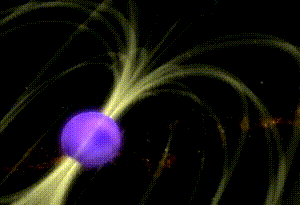Magnetars are a type of neutron star that is formed during supernova core collapses. During the collapse of a supernova, the core is crushed down to a fraction of its former size but maintains the same mass, making it extremely dense. The rotation of this dense core is extremely high (due to the conservation of angular motion). These newly formed magnetar stars rotate so fast that they are able to fully rotate around themselves in milliseconds - seconds. Magnetar stars are made up of mostly neutrons. The closest magnetar lives 50,000 light years away on the other side of the Milky Way galaxy, so there are no high-quality images of it yet.
 |
| Artist Interpretation of a Magnetar |
How magnetic are magnetars?
Magnetars have magnetic fields as strong as 10¹⁴-10¹⁵ Gauss, making it the most magnetic object (known) in the Universe. To give an idea, 10¹⁴ is 100,000,000,000,000. A magnetars magnetic field is 1 billion times stronger than what can be produced in a lab.
- Earth’s magnetic field (which deflects compass needles) = 0.6 Gauss
- A common commercial magnet = ~100 Gauss
- Sunspots (the most magnetic parts of the Sun) = ~3,000 Gauss
- MRI machines = Up to 70,000 Gauss
- The strongest steady magnetic field produced in labs = 450,000 Gauss
- Highly magnetized white dwarf stars = Up to 1 billion Gauss
- Typical neutron stars = ~1 trillion Gauss
The strong magnetic field squeezes atoms in the direction of the field, distorting atoms into needle-like shapes:
 |
| Distortion of a Hydrogen Atom When In a Magnetar's Magnetic Field |
Deadly magnetars
Magnetar blasts are caused by the disturbance of the magnetic field. The magnetic fields are shaken and release large amounts of energy in the form of gamma rays.
December 27, 2004, was the last noted magnetar blast. The energy blast was so intense that it flooded NASA’s Swift telescope detectors, a spacecraft designed to observe gamma-ray bursts. In a mere 1/5th of a second, the magnetar gave off as much energy as our Sun would in 250,000 years! If the magnetar had been within 1,000 light years, it could have easily triggered a mass-extinction event on Earth.
 |
| Depiction of a magnetar blast |
Comments
Post a Comment